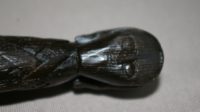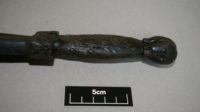 A Viking-era wooden weaver’s sword has been unearthed in Cork City, Ireland, at the site of the Beamish & Crawford brewery on South Main Street in the historic medieval city center. It’s not really a sword; that’s just the common name for it. It’s more of a utility tool, the blunt side used to hammer down threads on a loom and the pointed end to pick the threads while weaving a pattern.
A Viking-era wooden weaver’s sword has been unearthed in Cork City, Ireland, at the site of the Beamish & Crawford brewery on South Main Street in the historic medieval city center. It’s not really a sword; that’s just the common name for it. It’s more of a utility tool, the blunt side used to hammer down threads on a loom and the pointed end to pick the threads while weaving a pattern.
The perfectly-preserved wooden sword is a little over 30cm in length, made entirely from yew, and features carved human faces typical of the Ringerike style of Viking art, dating it roughly to the late 11th century.
Consultant archaeologist Dr Maurice Hurley said it was one of several artefacts of “exceptional significance” unearthed during recent excavations at the South Main Street site, which also revealed intact ground plans of 19 Viking houses, remnants of central hearths and bedding material.
“For a long time there was a belief that the strongest Viking influence was on Dublin and Waterford, but the full spectrum of evidence shows that Cork was in the same cultural sphere and that its development was very similar,” he said.
“A couple of objects similar to the weaver’s sword have been found in Wood Quay [IN DUBLIN], but nothing of the quality of craftsmanship and preservation of this one,” said Dr Hurley, adding that it was “quite miraculous” how the various wooden items had survived underground in such pristine condition.
 Not miraculous, exactly. Just your basic science: waterlogged earth is low in or missing oxygen and the microorganisms that consume organic materials can’t live in that environment. That’s how we get perfectly preserved wooden daggers, textiles, letters written on birch bark, human bodies, etc.
Not miraculous, exactly. Just your basic science: waterlogged earth is low in or missing oxygen and the microorganisms that consume organic materials can’t live in that environment. That’s how we get perfectly preserved wooden daggers, textiles, letters written on birch bark, human bodies, etc.
Founded by two businessmen, William Beamish and William Crawford in 1792 by acquiring an even older brewery (there may have been beer made at that location as early as 1500), the Beamish & Crawford brewery sold 12,000 barrels its first year. By 1805, less than 15 years after its founding, it was producing more than 100,000 barrels a year, making it the largest brewery in Ireland and the third largest in the UK. It held that position until 1833 when it was overtaken by Guinness.
In more recent history, B & C’s parent company was bought out by Heineken who shuttered the brewery on South Main in 2009. The buildings were left to their own devices and the inevitable ensued: in 2011, the site was declared derelict. It was still derelict in 2014 when the Heineken and developers BAM Ireland proposed it be turned into a multi-use events space. Cork City Council approved the plans and things seemed good to go, but the project has been beset with delays, overruns and unexpected expenses.
 All the archaeological materials found there haven’t exactly helped the construction come in on time and on budget, but they have generated a great deal of excitement and interest. Cork Lord Mayor Cllr Tony Fitzgerald, who was thrilled to have the opportunity to hold the dagger, thinks these discoveries will put Cork’s Viking history on the map for once. Dublin and Waterford get all the attention for their Viking history. The extent and quality of the finds indicate that Cork was similarly settled and influenced by Viking culture.
All the archaeological materials found there haven’t exactly helped the construction come in on time and on budget, but they have generated a great deal of excitement and interest. Cork Lord Mayor Cllr Tony Fitzgerald, who was thrilled to have the opportunity to hold the dagger, thinks these discoveries will put Cork’s Viking history on the map for once. Dublin and Waterford get all the attention for their Viking history. The extent and quality of the finds indicate that Cork was similarly settled and influenced by Viking culture.
The artifacts excavated at Beamish & Crawford are now at the National Museum of Ireland where experts are studying them and conserving them to ensure their long-term stability now that they’re no longer in their protective anaerobic environment. There’s a chance they might go on display at the Cork Public Museum in the future, perhaps as part of an exhibition on the Vikings in Cork. The mayor thinks that because interest in the weaver’s sword and other objects is so strong, they might get fast-tracked into an exhibition by February 2018.